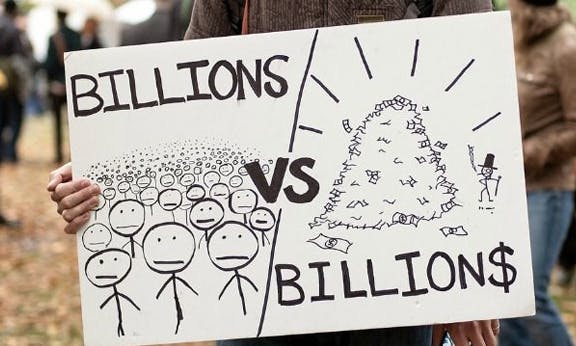Australia’s ‘New Gilded Age’

What would you do with $1.5 million? You could put down deposits on ten median-priced Sydney houses, or you could buy one outright and spare yourself the crushing mortgage repayments.
What about the next $1.5 million? And the next? If you were mining barons Gina Rinehart and Andrew “Twiggy” Forrest or billionaire real estate developer Harry Triguboff, the question would be posed repeatedly. Since 2020, the three richest Australians have collectively amassed this much money every hour.
Twenty-four hours a day, seven days a week, for four years.
Welcome to the “New Gilded Age”. That’s what British charity Oxfam is calling this era of post-pandemic wealth accumulation. Its 2024 report Inequality Inc. estimates that Rinehart, Forrest and Triguboff have increased their wealth by $50 billion, while the richest 47 Australians enjoyed a 70 percent surge.
It seems like impossible fortunes to spend, but they find ways. Twiggy’s got a $42 million luxury resort island off the Great Barrier Reef. Triguboff bulldozed and rebuilt his $100 million Vaucluse compound. With their recent respective buyouts of R.M. Williams and Akubra (Twiggy), Driza Bone and Rossi Boots (Gina), Australia’s two biggest mining bosses are trapped in a sartorial showdown: who can most own the high-fashion-outback-billionaire look?
“You’re rich, but are you family office rich?”, Primrose Riordan asks in the Australian Financial Review. Family offices deal with dynastic fortunes so enormous that the families in question require full-time staffers to manage them. These firms have doubled to more than 2,000 in a decade, KMPG researchers say, and offer discretion or downright secrecy for clients.
“They don’t want the employees of the company knowing what they are investing in or spending their money on”, one family office founder explained. When surveyed by the Private Wealth Network, 70 percent of family office clients said they hid their wealth from friends and relatives too, to avoid the “awkward”, “uncomfortable” and “isolating” situation of being asked to share any of it.
If the age doesn’t feel very gilded for you, it’s because you’re footing the bill. These fortunes are built dollar by dollar on the labour and losses of the rest of us. Underneath Australia’s rosy image as an egalitarian “lucky country” lies a deep and wide class divide. There is luxury and extravagance above us, and poverty all around.
Even before the pandemic, in the decade after the 2008 Global Financial Crisis, a staggering 93 percent of the benefits of all economic growth in Australia went to the richest 10 percent, according to research by the think tank Australia Institute.
Now, an even greater transfer of wealth from workers to bosses is taking place. Real wages last year fell at their fastest rate in four decades. Rising prices on the shelves have forced 70 percent of people to cut back on groceries, a Guardian Essential poll found last year.
For corporate profits, it’s the opposite. A new report on price gouging from former Australian Consumer and Competition Commission chair Allan Fels tells us that they reached their highest level ever recorded in 2022 and were the key driver of inflation.
On housing too, it is the best of times and worst of times. Rents are up 30 percent since 2020, according to CoreLogic’s latest Rate Review. So are property developer Lang Walker’s profits, the Financial Review informs us. Mortgage costs have skyrocketed with interest rate rises, while the big banks recorded $32.5 billion in profits last year.
Colleen Carina, a 60-year-old assistant nurse working in aged care, is living out of a Coffs Harbour motel room provided by Mission Australia. “I’m looking at rentals at $460 a week”, she told the Guardian in August. “Say I’m making my average wage, maybe $600 or $700 a week, by the time you pay for fuel, you put money away for electricity, or even a car account—how do you live?”
If you ask the rich, it’s Colleen’s own fault. Once workers cut back on non-essentials like haircuts and dental care, we’ll finally have more money to give to our needy banks. “Put your shoulder to the wheel”, Sally Tindall, research director at RateCity implored ABC radio listeners on 7 February. “If you put just an extra $200 a week to your mortgage, you could save tens of thousands of dollars down the line.”
It is tempting to think that, because our hard work appears like magic in their bank accounts, the rich are sincerely this uncoupled from reality. But then they give the game away. In a clip since gone viral, developer Tim Gurner tells a Financial Review Property Summit that workers have forgotten their place:
“We need to see unemployment rise—unemployment has to jump 40 to 50 percent, in my view. We need to see pain in the economy. We need to remind people that they work for the employer, not the other way around.”
Gurner belongs to a new generation of “longevity bros” with so much money they are terrified of dying before spending it all. With $150 million, he is opening a chain of exclusive anti-ageing clubs called Saint Haven. Members will pay tens of thousands a year to access meditation caves, cryotherapy, IV drips and spiritual healers.
“It’s not just superstar business elite, we’ve got an incredible musician who will be a member, we’ve got one of the top bankers in Australia, we’ve got a jewellery store owner, an artist and a restaurant owner, a completely diverse mix”, Gurner explained to the Financial Review, before adding that “it will be quite cult-like”.
I’ll take the eternal abyss, thanks.
“Corporate power”, Oxfam says, “is an unrelenting inequality-generating machine”. Fuelled by increased exploitation, the machine is speeding up.